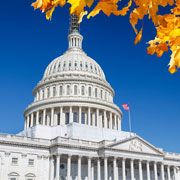5 min read
Federal Government Tax-related Actions Taken to-date Regarding COVID-19
 TMA Accounting
:
March 26, 2020
TMA Accounting
:
March 26, 2020

Right now, your highest priority is the health of those you love and yourself. But if you have time to read about some non-medical but important matters related to the health crisis, here is a summary of IRS action already taken and federal tax legislation already enacted to ease tax compliance burdens and economic pain caused by COVID-19 (commonly referred to as Coronavirus).
We will be sending you summaries of additional developments as they take place.
Filing and payment deadlines are deferred
After briefly offering more limited relief, the IRS almost immediately pivoted to a policy that provides the following to all taxpayers—meaning all individuals, trusts, estates, partnerships, associations, companies, or corporations regardless of whether or how much they are affected by COVID-19:
- For a taxpayer with a Federal income tax return or a Federal income tax payment due on April 15, 2020, the due date for filing and paying is automatically postponed to July 15, 2020, regardless of the size of the payment owed.
- The taxpayer doesn’t have to file Form 4868 (automatic extensions for individuals) or Form 7004 (certain other automatic extensions) to get the extension.
- The relief is for (A) Federal income tax payments (including tax payments on self-employment income) and Federal income tax returns due on April 15, 2020, for the person’s 2019 tax year, and (B) Federal estimated income tax payments (including tax payments on self-employment income) due on April 15, 2020, for the person’s 2020 tax year.
- No extension is provided for the payment or deposit of any other type of Federal tax (e.g. estate or gift taxes) or the filing of any Federal information return.
- As a result of the return filing and tax payment postponement from April 15, 2020, to July 15, 2020, that period is disregarded in the calculation of any interest, penalty, or addition to tax for failure to file the postponed income tax returns or pay the postponed income taxes. Interest, penalties, and additions to tax will begin to accrue again on July 16, 2020.
Favorable treatment for COVID-19 payments from Health Savings Accounts
Health savings accounts (HSAs) have both advantages and disadvantages relative to Flexible Spending Accounts when paying for health expenses with untaxed dollars. One disadvantage is that a qualifying HSA may not reimburse an account beneficiary for medical expenses until those expenses exceed the required deductible levels.
But the IRS has announced that payments from an HSA that are made to test for or treat COVID-19 don’t affect the status of the account as an HSA (and don’t cause a tax for the account holder) even if the HSA deductible hasn’t been met. Vaccinations continue to be treated as preventative measures that can be paid for without regard to the deductible amount.
Tax credits and a tax exemption to lessen the burden of COVID-19 business mandates. On March 18, President Trump signed into law the Families First Coronavirus Response Act (the Act, PL 116-127), which eased the compliance burden on businesses. The Act includes the four tax credits and one tax exemption discussed below.
Payroll tax credit for required paid sick leave (the payroll sick leave credit)
The Emergency Paid Sick Leave Act (EPSLA) division of the Act generally requires private employers with fewer than 500 employees to provide 80 hours of paid sick time to employees who are unable to work for virus-related reasons (with an administrative exemption for less-than-50-employee businesses that the leave mandate puts in jeopardy).
The pay is up to $511 per day with a $5,110 overall limit for an employee directly affected by the virus and up to $200 per day with a $2,000 overall limit for an employee who is a caregiver.
The tax credit corresponding with the EPSLA mandate is a credit against the employer’s 6.2% portion of the Social Security (OASDI) payroll tax (or against the Railroad Retirement tax). The credit amount generally tracks the $511/$5,110 and $200/$2,000 per-employee limits described above.
The credit can be increased by (1) the amount of certain expenses in connection with a qualified health plan if the expenses are excludible from employee income and (2) the employer’s share of the payroll Medicare hospital tax imposed on any payments required under the EPSLA.
Credit amounts earned in excess of the employer’s 6.2% Social Security (OASDI) tax (or in excess of the Railroad Retirement tax) are refundable. The credit is electable and includes provisions that prevent double tax benefits (for example, using the same wages to get the benefit of the credit and of the current law employer credit for paid family and medical leave).
The credit applies to wages paid in a period (1) beginning on a date determined by IRS that is no later than April 2, 2020, and (2) ending on December 31, 2020.
Income tax sick leave credit for the self-employed (self-employed sick leave credit)
The Act provides a refundable income tax credit (including against the taxes on self-employment income and net investment income) for sick leave to a self-employed person by treating the self-employed person both as an employer and an employee for credit purposes.
Thus, with some limits, the self-employed person is eligible for a sick leave credit to the extent that an employer would earn the payroll sick leave credit if the self-employed person were an employee.
Accordingly, the self-employed person can receive an income tax credit with a maximum value of $5,110 or $2,000 per the payroll sick leave credit. However, those amounts are decreased to the extent that the self-employed person has insufficient self-employment income determined under a formula or to the extent that the self-employed person has received paid sick leave from an employer under the Act.
The credit applies to a period (1) beginning on a date determined by the IRS that is no later than April 2, 2020, and (2) ending on December 31, 2020.
Payroll tax credit for required paid family leave (the payroll family leave credit)
The Emergency Family and Medical Leave Expansion Act (EFMLEA) division of the Act requires employers with fewer than 500 employees to provide both paid and unpaid leave (with an administrative exemption for less-than-50-employee businesses that the leave mandate puts in jeopardy).
The leave generally is available when an employee must take off to care for the employee’s child under age 18 because of a COVID-19 emergency declared by a federal, state, or local authority that either (1) closes a school or childcare place or (2) makes a childcare provider unavailable. Generally, the first 10 days of leave can be unpaid, and then paid leave is required, pegged to the employee’s pay rate and pay hours.
However, the paid leave can’t exceed $200 per day and $10,000 in the aggregate per employee.
The tax credit corresponding with the EFMLEA mandate is a credit against the employer’s 6.2% portion of the Social Security (OASDI) payroll tax (or against the Railroad Retirement tax). The credit generally tracks the $200/$10,000 per employee limits described above.
The other important rules for the credit, including its effective period, are the same as those described above for the payroll sick leave credit.
Income tax family leave credit for the self-employed (self-employed family leave credit)
The Act provides the self-employed a refundable income tax credit (including against the taxes on self-employment income and net investment income) for family leave similar to the self-employed sick leave credit discussed above.
Thus, a self-employed person is treated as both an employer and an employee for purposes of the credit and is eligible for the credit to the extent that an employer would earn the payroll family leave credit if the self-employed person were an employee.
Accordingly, the self-employed person can receive an income tax credit with a maximum value of $10,000 as per the payroll family leave credit.
However, under rules similar to those for the self-employed sick leave credit, that amount is decreased to the extent that the self-employed person has insufficient self-employment income determined under a formula or to the extent that the self-employed person has received paid family leave from an employer under the Act.
The credit applies to a period (1) beginning on a date determined by IRS that is no later than April 2, 2020, and (2) ending on December 31, 2020.
Exemption for employer’s portion of any Social Security (OASDI) payroll tax or railroad retirement tax arising from required payments
Wages paid as required sick leave payments because of EPSLA or as required family leave payments under EFMLEA aren’t considered wages for purposes of the employer’s 6.2% portion of the Social Security (OASDI) payroll tax or for purposes of the Railroad Retirement tax.
IRS information site. Ongoing information on the IRS and tax legislation response to COVID-19 can be found here.
Please feel free to contact us at any time with questions about the above information or any other matters related to COVID-19 or not.
We wish all of you the very best in a difficult time.
Disclaimer:Nothing in this post constitutes legal, tax or financial advice and is intended for informational and educational purposes only. This informational and educational material is not intended, and must not be taken, as legal, tax or financial advice on any particular set of facts or circumstances or as recommendations that are suitable for any specific person. You need to contact a lawyer, accountant or financial adviser licensed in your jurisdiction for advice on your specific questions, issues and concerns. View our full Terms of Use here.



